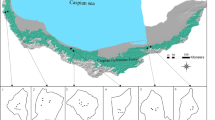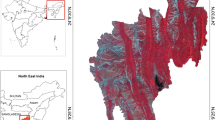Abstract
The study site is located in Qianyanzhou experimental station and the surrounding area. Based on CBERS-02 satellite data and field measurement, we not only discussed the relationship between NDVI and biomass of two species of coniferous plantations, namely,Pinus massoniana Lamb andPinus elliottii Engelm, but also introduced the biomass models based on NDVI. The comparison between measured biomass in Qianyanzhou and biomass derived from CBERS-02 CCD data showed that it is feasible to estimate biomass based on NDVI. But its limitations cannot be ignored. This kind of model depends on the dominant vegetation species. There are some effect factors in estimating biomass based on NDVI. This paper analyzes these factors based on fine-resolution CBERS-02 CCD data and some conclusions are drawn: In Qianyanzhou, the area with good vegetation coverage, the nonlinearity of NDVI has little influence on scaling-up of NDVI. As a result of surface heterogeneity, scaling-up can cause NDVI within each pixel to change. Because scaling-up can cause pixel attribute to change, the applicability of biomass model is one of the sources of error in estimating biomass.
Similar content being viewed by others
References
Houghton, R. A., Terrestrial sources and sinks of carbon inferred from terrestrial data, Tellus, 1996, (48B): 420–432.
Tans, P. P., Fung, I. Y., Takahashi, T., Observational constraints on the global atmospheric CO2 budget, Science, 1990, 247: 1431–1438.
Sedjo, R. A., Toman, M., Can carbon sinks be operational? Resources for the Future (RFF) Workshop Proceedings (eds. Sedjo, R. A., Toman, M.), Resources for the Future, Washington, DC: 2001, 1–5.
Houghton, R. A., Skole, D. L., Nobre, C. A. et al., Annual fluxes or carbon from deforestation and regrowth in the Brazilian Amazon, Nature, 2000 (403): 301–304.
Keller, M., Palace, M., Hurtt, G., Biomass estimation in the Tapajos National Forest, Brazil. Examination of sampling and allometric uncertainties, Forest Ecology and Management, 2001 (154): 371–382.
Michael, A. L., Warren, B., Geoffrey, G. et al., Lidar remote sensing for ecosystem studies. BioScience, 2002, 52(1): 19–30.
Myneni, R. B., Keeling, C. D., Tucker, C. J. et al., Increased plant growth in northern high latitudes from 1981–1991, Nature, 1997, 386: 698–702.
Myneni, R. B. J., Dong, C. J., Tucker, R. K. et al., A large carbon sink in the woody biomass of Northern forests, PNAS, 2001, 98(26): 14784–14789.
Prince, S. D., Satellite remote sensing of primary production: Comparison of results for Sahelian grasslands 1981–1988, International Journal of Remote Sensing, 1991, 12: 1301–1312.
Tucker, C. J., Holben, B. N., Elgin, J. H. et al., Remote sensing of total dry matter accumulation in winter wheat, Remote Sensing of Environment, 1981, 11: 171–189.
Tucker, C. J., Vanpraet, C. L., Sharman, M. J. et al., Satellite remote sensing of total herbaceous biomass production in the Senegalese Sahel: 1980–1984, Remote Sensing of Environment, 1985, 17: 233–249.
Song, X., Liu, Y. F., Xu, X. F. et al., Comparison study on carbon dioxide, water and heat flux of the forest ecosystem in red earth hilly zone over winter and spring, Resources Science (in Chinese), 2004, 26(3): 96–104.
Qian, G. Q., Studies on the dynamic change of the net production quantity of Liquisambar formosana plantation, Acta Agriculture Universitatis Jiangxiensis (in Chinese), 2000, 22(3): 399–404.
Li, X. Y., Gu, X. F., Min, X. J. et al., Radiometric cross-calibration of the CEBERS-02 CCD camera with the TERRAMODIS, Science in China, Ser. E. 2005, 48(Supp. I): 44–60
Rouse, J. W., Haas, R. H., Monitoring vegetation systems in the great plain with ERTS, in Third ERTS Symposium, Washington, DC: NASA, 1973, (1): 309–317.
Yu, T., Li, X. Y., Zhang, Y. et al., Comparison of the influence factors on NDVI for CCD camera and WFI imager on CBERS-02, Science in China, Series E, 2005, 48(Supp. I): 100–115.
Takeuchi, W., Tamura, M., Yasuoka, Y., Estimation of methane emission from West Siberian wetland by scaling technique between NOAA AVHRR and SPOT HRV, Remote Sensing of Environment, 2003, 85(1): 21–29.
Author information
Authors and Affiliations
Corresponding author
Rights and permissions
About this article
Cite this article
Chen, L., Gao, Y., Cheng, Y. et al. Biomass estimation and uncertainty analysis based on CBERS-02 CCD camera data and field measurement. Sci. China Ser. E-Technol. Sci. 48 (Suppl 2), 116–128 (2005). https://doi.org/10.1007/BF03039429
Received:
Issue Date:
DOI: https://doi.org/10.1007/BF03039429




